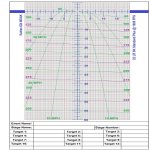22 LR Ballistics and Plotting Sheet for PRS CRPS Style shooting.
Over the thanksgiving weekend I had a little time and noodled around in MS Paint to create this.
This was developed for 71 degrees F, but next time I have a little time, I'll add a second line for each distance to show the relative effect of colder weather.
I'll be testing this format out as a means of tracking try dope vs actual during PRS matches. This way there's a history that can be studied to identify where improvement can be made.
The resolution on this image is reduced to fit, so it wont read as well as the full size version.
This was made for MOA, since that's what I use. Sorry Mil guys.

Over the thanksgiving weekend I had a little time and noodled around in MS Paint to create this.
This was developed for 71 degrees F, but next time I have a little time, I'll add a second line for each distance to show the relative effect of colder weather.
I'll be testing this format out as a means of tracking try dope vs actual during PRS matches. This way there's a history that can be studied to identify where improvement can be made.
The resolution on this image is reduced to fit, so it wont read as well as the full size version.
This was made for MOA, since that's what I use. Sorry Mil guys.

Attachments
Last edited:








































































